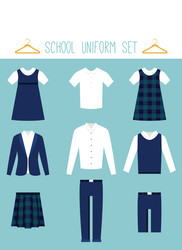The Benefits of School Uniforms
27th Mar 2023
School uniforms are a topic of much debate in the education system. Some people argue that school uniforms are an unnecessary expense and an infringement on students' freedom of expression, while others believe that uniforms have many benefits. In this blog, we will explore the reasons why school uniforms are good for students and their schools.
Part 1: The Benefits of School Uniforms
- Equality and Inclusivity
School uniforms promote equality and inclusivity by removing the differences in dress that may exist between students from different economic backgrounds. When everyone is wearing the same clothing, it eliminates the pressure on students to wear expensive and trendy clothing to fit in with their peers. This promotes a sense of community and inclusivity, as everyone is part of the same team.
- Improved Discipline
One of the main reasons why schools implement uniforms is to improve discipline. When everyone is dressed in the same clothing, it eliminates the distraction of fashion and reduces the chances of clothing-related conflicts. It also makes it easier for teachers and administrators to enforce dress codes and maintain a professional learning environment.
- Safety
School uniforms can also promote safety by making it easier for staff members to identify students on campus. This is particularly important in large schools or schools with high student turnover. It also reduces the risk of outsiders entering the school and posing as students, which can be a significant security risk.
- Improved Academic Performance
Studies have shown that school uniforms can lead to improved academic performance. When students are dressed in the same clothing, it reduces the pressure to conform to fashion trends and can help them focus on their studies. It can also improve their sense of belonging and create a more positive school environment.
- Time and Money Savings
School uniforms can also save students and parents time and money. Instead of spending time each morning trying to decide what to wear, students can simply put on their uniforms and be ready for school. Additionally, uniforms can be less expensive than trendy clothing, and they can often be purchased in bulk or handed down from older siblings.
Part 2: Addressing Common Criticisms of School Uniforms
- Infringement on Freedom of Expression
One of the most common criticisms of school uniforms is that they infringe on students' freedom of expression. However, many schools allow students to express themselves through accessories, such as jewelry, hats, and scarves. Additionally, some schools have implemented "dress-down" days, where students can wear their own clothing on certain days of the year.
- Cost
Another criticism of school uniforms is that they can be expensive, particularly for low-income families. However, many schools offer financial assistance programs for families who cannot afford uniforms, and some schools have implemented uniform exchange programs where students can exchange uniforms that no longer fit for ones that do.
- Lack of Individuality
Some people argue that school uniforms promote a lack of individuality and creativity. However, students can still express their individuality through their accessories and hairstyles, and many schools allow students to personalize their uniforms with patches, embroidery, or pins.
Part 3: Examples of Successful School Uniform Programs
- Long Beach Unified School District
The Long Beach Unified School District in California implemented a mandatory school uniform policy in 1994. The policy was met with resistance at first, but it has since been widely embraced by the community. The school district has reported improved academic performance, reduced discipline problems, and increased attendance rates since the policy was implemented.
- Japan
In Japan, school uniforms have been a part of the education system for many years. Uniforms are mandatory in most schools, and they are often worn even on weekends and holidays. The uniforms promote a sense of community and discipline, and they have become an iconic symbol of Japanese culture.

